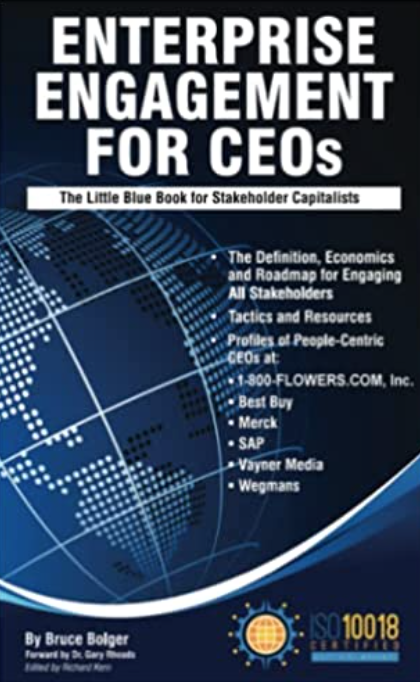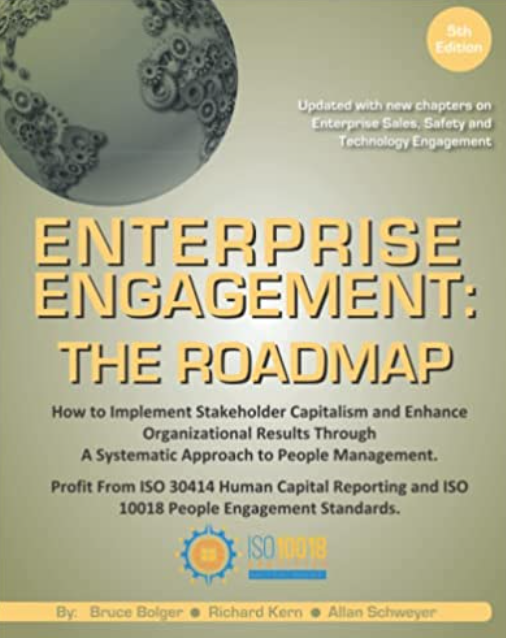Size Matters When it Comes to Corporate Sustainability Reporting
 This is the second in a multi-part series on the creation of Corporate Sustainability Reports for all sizes and types of organizations. This article focuses on considerations for the strategy for Corporate Sustainability reporting based on the size of the organization. For Part 1 of this series, click here: Is It Time for Your Organization to Publish a Corporate Sustainability Report.
This is the second in a multi-part series on the creation of Corporate Sustainability Reports for all sizes and types of organizations. This article focuses on considerations for the strategy for Corporate Sustainability reporting based on the size of the organization. For Part 1 of this series, click here: Is It Time for Your Organization to Publish a Corporate Sustainability Report.By Bruce Bolger
Considerations for Organizations Subject to the Law
SMEs (Small to Medium Size Enterprises)
How to address Corporate Sustainability Reporting starts with determining if your organization will have to comply with the new European law. It is aimed at companies with at least 250 employees or $40 million euro ($44 million) in annual sales, and involves to varying extents—based on size—their supply chain and distribution partners. Because the stated intention of the Corporate Sustainability Reporting Directive is to level the playing field, organizations that wish to publish a report in the spirit of the directive but which do not fall within its legal size requirements must be careful, because their competitors will not be compelled to make any disclosures and may not choose to do so.
For organizations that eventually will be required to publish Corporate Sustainability Reports, it makes sense to start by gaining a full understanding of the new disclosure law; it’s intent; framework; process, metrics, etc. Click here for a complete EEA guide to creating a Corporate Sustainability Report consistent with the new law, including an appendix providing details on the requirements for employees; employees of distribution and supply chain partners; customers, and communities, which includes environmental impact.
Given that the European Union Corporate Sustainability Reporting Directive has developed a very clear reporting framework for potentially over 60,000 public and private organizations, including thousands in the US subject to the disclosure law, and because the reports will eventually require independent audits, it makes sense to use it as a framework for reporting, whether a company will ever be subject to formal EU filings and eventual audits. On the other hand, it is completely understandable that companies not required to report would be cautious about disclosing information their competitors can legally withhold.
Considerations for Organizations Subject to the Law 
For those organizations that fall within the purview of the law, the approach is rather straightforward. As explained in the EEA Guide to Corporate Sustainability Reporting, the first decision is to determine if the organization wishes to view reporting as a compliance issue to be addressed on a defensive posture, or a business opportunity for competitive advantage by substantiating in clear terms claims made in marketing and communications.
A compliance stance. If taking a defensive posture, the task is best given to the legal department to focus on meeting the bare minimum of the requirements, which do provide wiggle-room by allowing organizations to explain why an organization is not providing specific metrics, if it states what they intend to do about it. Because the framers of the directive have made it clear that they will give organizations time to address the full intent of the law—audits will not be required in the first few years—the logical defensive view is to kick the issue down the road and minimize internal disruption or curiosity as much as possible. In fact, while companies subject to the law will have to file the reports annually in a public database, there is no requirement to publish them on their own web sites or publicize them in any way.
A business opportunity. Those organizations that choose to embrace the new law as a means of better aligning organizational purpose, goals, and objectives with the interests of the customers, employees, distribution and supply chain partners, and communities needed to fulfill them will put either a single executive in charge of the initiative or a combination of marketing, human resources, finance, etc. supported by legal counsel at every step of the way. The implementation process provides an opportunity to address all the key human factors addressing an organization across all stakeholders, including DEI, job design, customer service, etc. in a systematic way so that all focus toward the accomplishment of the purpose, goals, and objectives of the organization. Organizations that already have a business operating system will have relatively little difficulty adopting. Those run on a more ad-hoc approach driven by KPIs (key performance indicator) will have a greater difficulty adjusting because they likely will lack a clear vision of the purpose, goals, and objectives of the organization; the specific methods used to achieve them at the front-line level, clear metrics, and continuous improvement processes.
In either case, consideration must be given to the fact that in the early years, reporting will be subject to “assurances” from the organization that the information provided is factual. Given that the stated intent of the law is to reduce greenwashing, there is every reason to believe the EU will follow through with its goal of requiring audited reports within the next few years.
SMEs (Small to Medium Size Enterprises)
Organizations that do business with European Union countries but which are below the reporting threshold, or those that believe their stakeholder management practices provide a competitive advantage, can use the framework without having to share specific details, subject to a few caveats.
When it comes to developing a Corporate Sustainability Reporting strategy, it makes sense to follow the same framework of the CSRD, and to report on the required subjects, i.e., one’s own workforce; the workforce management practices of supply chain and distribution partners; customer and community engagement processes, including the environment. This is especially true for smaller companies that do business with big organizations. It’s also a marketing opportunity for an organization to demonstrate how it keeps its promises; if or how the organization negatively or positively affects stakeholders, and how ESG issues can affect its business as well—the concept of double materiality.
However, when it comes to disclosing metrics that might be deemed competitive, the report for such companies that do not fall under the law can address the issue without having to disclose precise metrics, other than to state the general trend and what is being done to address any issues. To make these reports more meaningful, the organization can have them audited by a certfied independent third party for the accuracy of claims made.
For instance, the Human Capital Report published before the announcement of the EU CSRD by Jetruby, an application development company with a US headquarters providing support from Eastern European and Middle Eastern developers mostly to US companies, had its human capital report independently audited based on the ISO 30414 standard used by the International Center for Enterprise Engagement. Its version of the standard includes all the employee issues included in ISO 30414, as well as customer, supply chain and distribution partner, and community engagement aspects included in the European directive.
For More Information
Bruce Bolger
Founder, Enterprise Engagement Alliance
914-591-7600, ext. 230
Bolger@TheEEA.org
Subscribe to ESM's weekly newsletter.
Click here to learn about the EEA’s bi-partisan Change.org petition to keep politicians out of business management.
 Profit From the “S” of Environmental, Social, Governance (ESG)
Profit From the “S” of Environmental, Social, Governance (ESG)
Through education, media, business development, advisory services, and outreach, the Enterprise Engagement Alliance supports boards, business analysts, the C-suite, management in finance, marketing, sales, human resources and operations, etc., educators, students and engagement solution providers seeking a competitive advantage by implementing a strategic and systematic approach to stakeholder engagement across the enterprise. Click here for details on all EEA and RRN media services.
1. Professional Education on Stakeholder Management and Total Rewards
Strategic Business Development for Stakeholder Management and Total Rewards solution providers, including Integrated blog, social media, and e-newsletter campaigns managed by content marketing experts.
4. Advisory Services for Organizations
Stakeholder Management Business Plans; Human Capital Management, Metrics, and Reporting for organizations, including ISO human capital certifications, and services for solution providers.
5. Outreach in the US and Around the World on Stakeholder Management and Total Rewards
The EEA promotes a strategic approach to people management and total rewards through its e-newsletters, web sites, and social media reaching 20,000 professionals a month and through other activities, such as:
 Profit From the “S” of Environmental, Social, Governance (ESG)
Profit From the “S” of Environmental, Social, Governance (ESG)Through education, media, business development, advisory services, and outreach, the Enterprise Engagement Alliance supports boards, business analysts, the C-suite, management in finance, marketing, sales, human resources and operations, etc., educators, students and engagement solution providers seeking a competitive advantage by implementing a strategic and systematic approach to stakeholder engagement across the enterprise. Click here for details on all EEA and RRN media services.
1. Professional Education on Stakeholder Management and Total Rewards
-
 Become part of the EEA as an individual, corporation, or solution provider to gain access to valuable learning, thought leadership, and marketing resources.
Become part of the EEA as an individual, corporation, or solution provider to gain access to valuable learning, thought leadership, and marketing resources. - The only education and certification program focusing on Stakeholder Engagement and Human Capital metrics and reporting, featuring seven members-only training videos that provide preparation for certification in Enterprise Engagement.
- EEA books: Paid EEA participants receive Enterprise Engagement for CEOs: The Little Blue Book for People-Centric Capitalists, a quick implementation guide for CEOs; Enterprise Engagement: The Roadmap 5th Edition implementation guide; a comprehensive textbook for practitioners, academics, and students, plus four books on theory and implementation from leaders in Stakeholder Management, Finance, Human Capital Management, and Culture.
- ESM at EnterpriseEngagement.org, EEXAdvisors.com marketplace, ESM e–newsletters, and library.
- RRN at RewardsRecognitionNetwork.com; BrandMediaCoalition.com marketplace, RRN e-newsletters, and library.
- EEA YouTube Channel with over three dozen how-to and insight videos and growing with nearly 100 expert guests.
Strategic Business Development for Stakeholder Management and Total Rewards solution providers, including Integrated blog, social media, and e-newsletter campaigns managed by content marketing experts.
4. Advisory Services for Organizations
Stakeholder Management Business Plans; Human Capital Management, Metrics, and Reporting for organizations, including ISO human capital certifications, and services for solution providers.
5. Outreach in the US and Around the World on Stakeholder Management and Total Rewards
The EEA promotes a strategic approach to people management and total rewards through its e-newsletters, web sites, and social media reaching 20,000 professionals a month and through other activities, such as:
- Association of National Advertisers Brand Engagement 360 Knowledge Center to educate brands and agencies.
- The EEA Engagement widget to promote, track, and measure customers/employee referrals and suggestions that can be connected to any rewards or front-end program management technology.
- The Stakeholder Capitalism free insignia to promote a commitment to better business.
- The BMC Brand Club and transactional storefronts to educate corporate and agency buyers on the IRR market.
- The EME Gold program to educate the top 3% of promotional consultants on selling engagement and rewards services.














